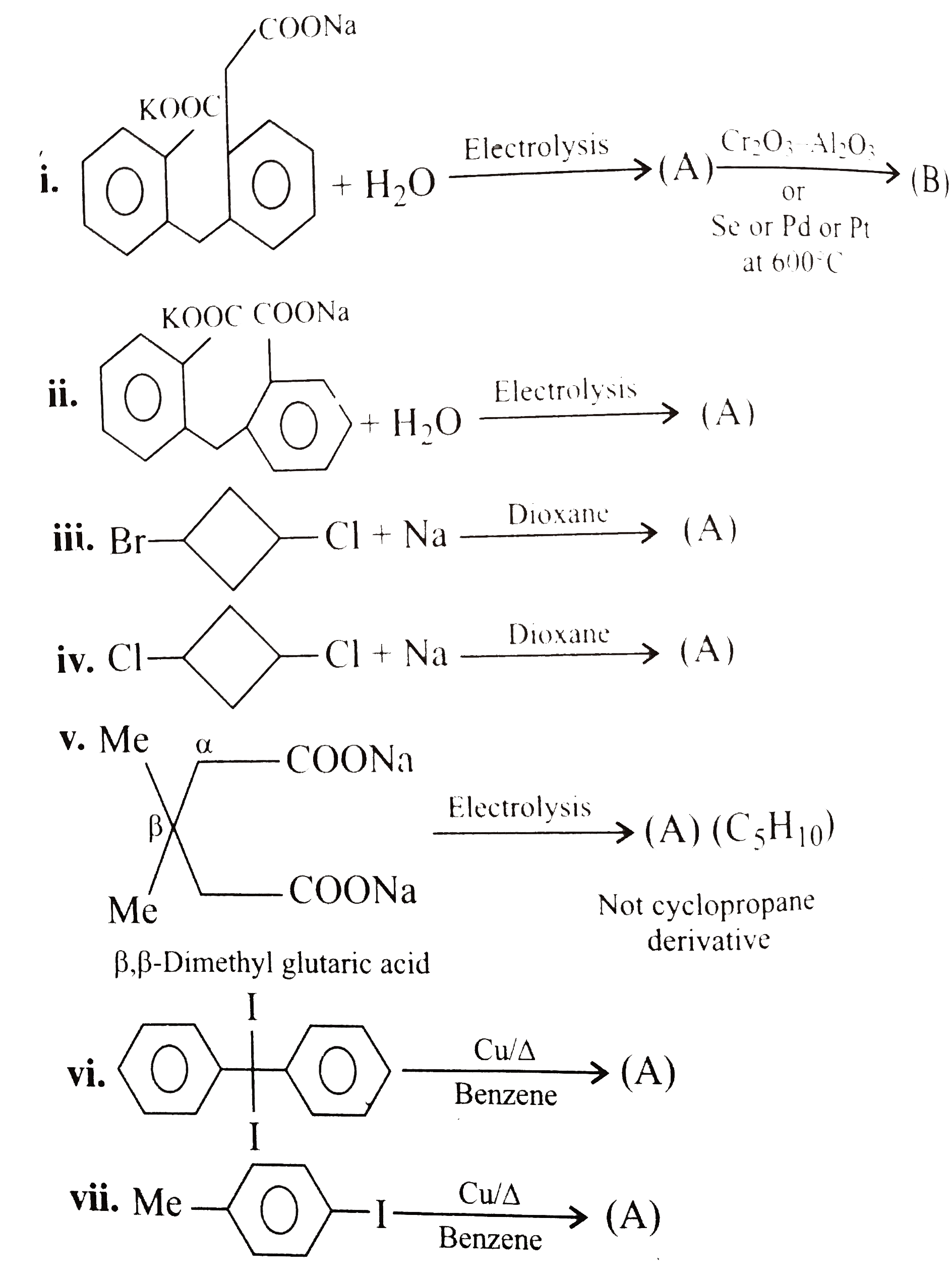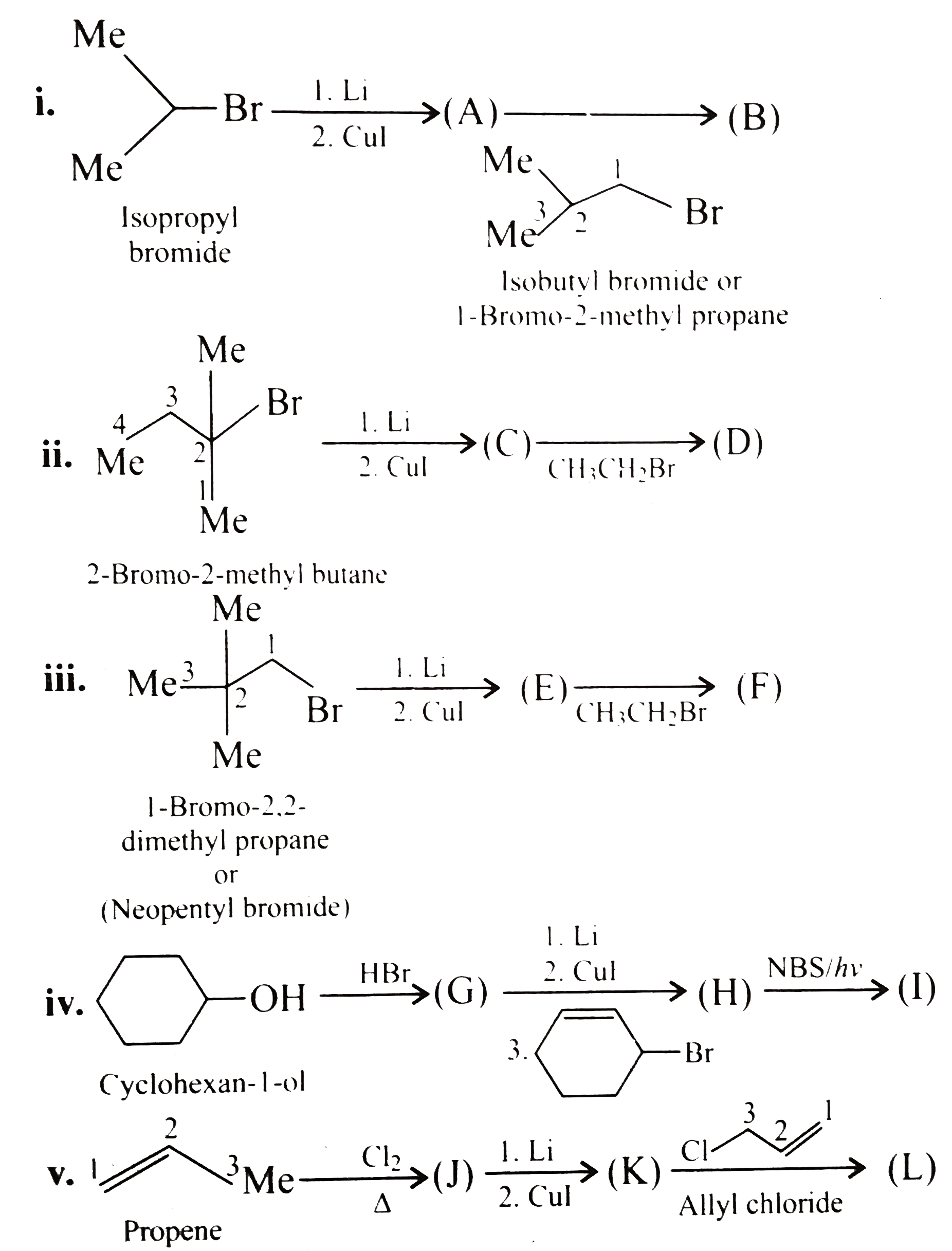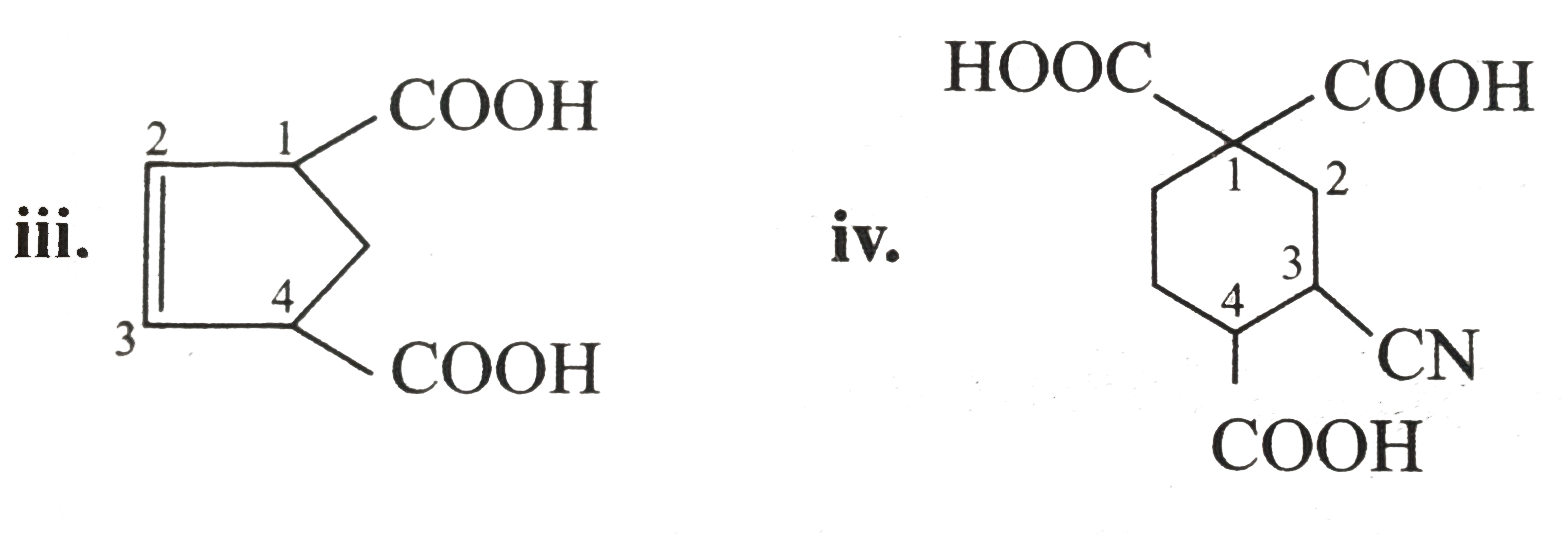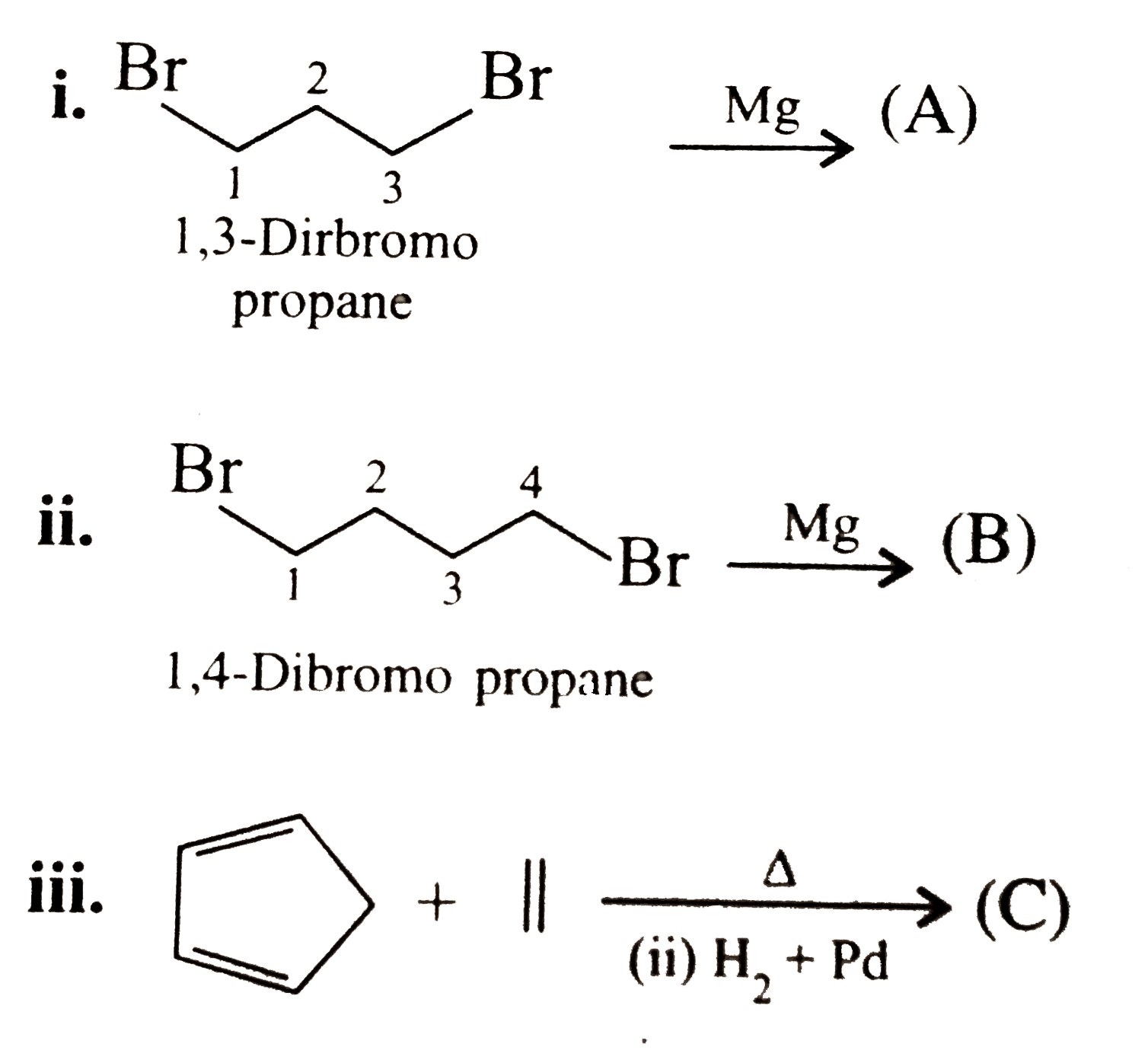Complete Solutions to Illustration of chapter ALKANES AND CYCLOALKANES of Class 11 book with complete answers and questions
| Class 11 | CHEMISTRY |
| Chapter | ALKANES AND CYCLOALKANES |
| CENGAGE CHEMISTRY | Illustration |
| Number Of Questions | 39 |
| Academic Year | 2023-24 |
(a) Write the IUPAC name of the compound (A) whose bond line structre is

(b) Write the condensed formula of the compound (A).
(c) Define and identify all the primary `(1^(@))`, secondary `(2^(@))`, tertiary `(3^(@))`, and quaternary `(4^(@))` carbon atoms.
(d) Identify all the `1^(@), 2^(@)`, and `3^(@)` H atoms.
(e) Given the number of H atoms bonded to `1^(@), 2^(@), 3^(@)`, and `4^(@)` C atom in an alkane.
(f) Given the number of C atoms bonded to `1^(@), 2^(@), 3^(@)`, and `4^(@)` C atoms bonded to `1^(@), 2^(@), 3^(@)`, and `4^(@)` C atom in an alkane.08:26View SolutionWrite the IUPAC name and condensed formula of the following compounds whose bond line structures are given as folllows:
(a) 06:53View Solution
06:53View SolutionWhat is wrong with the following names ? Drawn the structures they represent and given their (a) correct IUPAC name, (b) write the corresponding corresponding bond line structures.
I. 1,1-Dimethyl pentane
II. 2-Methyl-2-propyl hexane
III. 3-Dimethyl pentane
IV. 4,4-Dimethyl-3-ethyl pentane
V. 3-Isopropyl pentane
VI. 3-Chloro-4-methyl pentane
VII. 4-(2-Methyl ethyl) heptane08:21View SolutionGiven the IUPAC name and bond structures of the following condensed formulae:
(a) `Pr_(2)CHCMe_(3)`
`Me_(3)C CH_(2)CM_(3)`04:52View SolutionWrite the IUPAC nam, bond line structure, and condensed formula for the following alkanes with the greatest number of (Me) groups.
`C_(7)H_(16)`
(b) `C_(8)H_(18)`
(c) `C_(10)H_(22)`
`C_(11)H_(24)`05:25View SolutionWrite the structure (s) of the simplest alkane (s), with fewest number of `C` atoms, possessing `1^(@), 2^(@), 3^(@)`, and `4^(@) C` atoms.
03:19View Solution(a) Write all the isomeric biyclic spiranes of a compound with formula
`C_(7)H_(12)`
(b) Write all the isomeric biyclic structures of the compound with formula `C_(7)H_(12)`.05:03View SolutionWhich of the following conformers for ethylene glycol is most stable ?
02:22View SolutionWhich conformer of propene, ethanal (acetaldehyde), and propanaldehyde is more stable?
03:30View Solution(a) Draw sawhorse projection formulae for the two eclipsed conformations of butane.
(b) What is the dihedral angle between adjaccent methyl groups? (c) Which conformer has greater torsional strain?05:08View Solutioni. `0.21` gm of but-3-yn-2-ol is treated with excess of `C_(2)H_(5)`MgBr at standard condition. The volume of gas evolved is:
(a) `134.4` ml, (b) `146.4` ml
(c) `67.2` ml, (d) `73.2` ml
ii. `0.46` gm of a compound with molecular mass of 92 gm gave 336 ml of a gas at STP when treated with excess of `CH_(3)`MgI. The number of moles in the compound is:
(a) `0.1`, (b) 2
(c) 3, (d) 4
iii. The treatement of `CH_(3)OH` with `CH_(3)Mgl` releases `1.04 ml` of a gas at STP. The mass of `CH_(3)OH` added is:
(a) `1.49` mg,
(b) `2.98` mg
(c) `3.71` mg, (d) `4047` mg
iv. The addition of `4.12` mg of an unknown alcohol, ROH, to `CH_(3)Mgl` releases `1.56` ml of a gas at STP. The molar mass of alcohol is:
(a) 32 gm `mol^(-1)` , (b) 46 gm `mol^(-1)`
(c) `59 gm mol^(-1)` , (d) 74 gm `mol^(-1)`
v. Teh sample of `1.79` mg of a compound of molar mass 90 gm `mol^(-1)` when treated with `CH_(3)Mgl` releases `1.34` mol of a gas at STP. The number of moles of active hydrogen in the molecule is:
(a) 1 , (b) 2
(c) 3 , (d) 403:31View Solutioni. `A + 2Na overset ("Dryehter") rarr Me_(2)CH - CJMe_(2)`
ii. `A + 2Na overset ("Dryether") rarr Me_(3)C - Cme_(3)`
iii. One mole of `CH_(3)Br` are reacted with 2 mole of sodium metal in dry ether. The productus thus obtained are:
a. Ethane + 2NaBr
b. Ethane + Propane + 2 NaBr
c. Ethane + Propane + Butane + 2 NaBr
d. Ethane + Propane + Butane + Ethene + 2 NaBr02:54View Solutioni. The volume of gases evolved at STP by passing `0.1 A` of current for 965 sec through an aqeous solution of potassium acetate is:
a. `22.4` ml , b. `11.2` ml
c. `89.6` ml , d. `44.8` ml
ii. The mass of gases eveolved in the above problem is:
a. `0.06` gm , b. `0.6` gm
c. `6.0` gm , d. 60 gm
iii. The volume of gases evolved at STP by passing `0.2 A` of current for 965 sec through an aqueous soultion of disodium fumerate is:
a. `22.4` ml , b. `11.2` ml
c. `89.6` ml , d. `44.8` ml10:42View SolutionComplete the following recations:
i. 12:56View Solution
12:56View Solutioni.
 16:41View Solution
16:41View SolutionAn alkane `C_(7)H_(16)` is produced by the reaction of lithium di(3-pentyl)cuprate with ethyl bromide. The name of the product is
04:17View SolutionI. Arrange the compounds of (a) in the order of decreasing boiling points and (b) in the order of decreasing solubility in water.
(A) (1) Ethanol, (2) Propane, (3) Pentanol
(B) (1) Butane, (2) 1,2,3-Pentane triol, (3) Butyl alcohol
(C) (1) Pentane, (2) Pentanol, (3) Hexanol
II. Arrange the following in the decreasing order of their boiling points.
(A) (1) `C_(3)H_(8)`, (2) `C_(2)H_(5)OH`, (3) `(CH_(3))_(2)O`, (4) `HOH_(2)C----CH_(2)OH`
(B) (1) 3-pentanol, (2) n-Pentane, (3) 2,2-Dimethyl propanol, (4) n-Pentanol
III. Arrange the following alcohols (a) in the decreasing order of their boilling points and (b) in the decreasing order of their solubility in water.
(1) n-Butyl alcohol
(2) sec-Butyl alcohol and
(3) tert-Butyl alcohol
IV. Arrange the following compounds in the order of their increasing boiling points.
(1) `CH_(3)COC1` , (2) `(CH_(3)CO)_(2)O` , (3) `CH_(3)CONH_(2)` , (4) `CH_(3)COOH`20:55View SolutionA sample of diesel has the same characteristics as a 60 ml mixture of cetane and `alpha` -methyl napthalene mixed in `2:1` ratio (v/v). What is the centane number of the diesel sample?
01:21View SolutionGive the decreasing order of the octane rating of the following:
i. 01:59View Solution
01:59View Solutionwas cane sugar First organic compound to be synthesised
01:28View SolutionDraw the structure of following compounds:
a. 2-Isopropyl-7-chlorobicyclo `[2.2.1]` heptane
b. 6-Ethan-3-Iodo bicyclo `[3.2.0]` heptane
c. 3-Methan tricyclo `[3.2.1.0]` ocation-3-ol
d. 1,4,6,9-Tetramethyl spiro `[4.4]` nonane
e. Bicyclo `[2.2.1]` heptane05:58View SolutionExplain and differentiate between the following terms.
a. Polycyclic compounds
b. Fused rings
c. Bicyclic compounds
d. Bridgehead C atoms
e. Bridge C atoms
f. Bridged bicyclics03:33View SolutionWhich of the following compounds show stereoisomers?
a. 2-Bromo spiro `[4.5]` decane
b. 8-Chloro spiro `[4.5]` decane02:07View SolutionGive the number of stereoisomers of the following compounds.
a. 2-Bromobicyclo `[2.2.1]` heptane or 2-bromo norborane
b. 2-Ethyl-7-bromo `[2.2.1]` heptane or 2-ethyl-7-bromonorborane04:19View SolutionClassify cycloalkanes by size and ring strain.
02:47View Solutiona. Draw (i) half chair, (ii) skew or twist boat cyclohexane conformation.
b. Why (i) the skew or twist boat conformation is more stable than the boat conformation, (ii) the half chair is the least stable conformation?06:34View SolutionDraw the boat conformation of ccyclohexane in Newman projection.
03:18View SolutionCompare the orbital overlap in cyclopropane and alkane.
02:27View Solutioni. Draw the conformation of cyclobutane that can overcome the eclipsing strain.
ii. Draw the puckered conformation of cyclobutane in Newman projection.04:35View SolutionWhich is more stable, cis - or trans-1,2-dimethyl cyclobutane and whyh?
02:47View SolutionWhich is more more stable, cis - or trans- 1,3-di-(methylcarboxylate) cyclobutane?
02:35View SolutionStructure of 1,3-dimethyl cyclohexane is?
01:50View SolutionWhich (------COOH) group is easaily decarboxylated on heating and why?
02:10View SolutionWhich (------COOH) group is lost as `CO_(2)` on heating in the following?
i. ii.
ii.  04:20View Solution
04:20View SolutionConvert cyclopentanone to cyclo-butanone and vice versa.
02:33View SolutionExplain:
a. Cyclopropane has the greatest ring strain, yet is readily synthesised.
b. Rings with more than six C atoms are stable but difficult to synthesise, nonetheless can be better achived at a very low concentraction of reactants.04:27View SolutionComplete the following. Also name the reaction and reaction type.
i. 05:00View Solution
05:00View SolutionIntramolecular ring closure to form cyclobutane is unfavourable, how would you synthesise cyclobutane from open-chain compounds?
02:02View SolutionHow many isomers are possible (includding geometrical isomers) on monobromination of methyl cyclohexane? Which isomer is in major amount? Compare with monochlorination products.
04:06View Solution
Illustration questions and complete solutions for chapter ALKANES AND CYCLOALKANES of CENGAGE CHEMISTRY (ENGLISH) of Class 11
